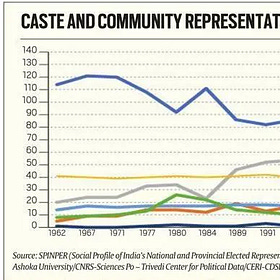Canadians went to the polls this week and completed a staggering turnaround for the Liberal party. Having trailed hugely at the start of the year, a new leader – suave former central banker Mark Carney – has found himself elected, via a minority, as the country's next PM. Is this a victory for technocratic leadership? Or have Canadian voters simply wanted to demonstrate their ideological distance from Donald Trump, who has been battling Canada on trade and inflaming national pride with remarks about it being "the 51st state"?
To look at this week's electoral shake-up, Emily Tamkin and Rohan Venkat are joined by political commentator and former Justin Trudeau speechwriter Colin Horgan.
Add The Political Cycle to your podcast player here, or listen on Spotify here.
Subscribe to Colin's Substack here!
Here are the Trike Recommendations from this episode:
Subscribe below to our contributors' Substacks:
ET Write Home by Emily Tamkin (via Emily's Substack you can also listen to an ad-free version of the show)
The Political Tricycle is a Podot podcast.
It's presented by Emily Tamkin, Tom Hamilton and Rohan Venkat.
Executive Producer: Nick Hilton.
Producer: Ewan Cameron
For sales and advertising, email nick@podotpods.com
10 Links
With everyone expecting a potential move on Pakistan following the Pahalgam attack, Prime Minister Narendra Modi’s big move this week ended up being domestic: Announcing a caste census, effectively acquiescing to a demand that had become the central electoral plank of the Congress over the past year.
For background, read this piece from two years ago:India Inside Out: What is driving demands for a 'caste census' ahead of the 2024 elections?
·Thank you for reading India Inside Out.
Scroll recounts how Modi, other BJP leaders spent the last few years opposing demand for caste census, with the prime minister even referring to demands for a caste census as “Maoist thinking”. Online commentary from the right-wing appears unsure about how to deal with the issue – outside of those who automatically label any Modi move as a masterstroke – with expectations about what might follow: specifically private sector reservations (i.e. extending affirmative action to businesses), as well as the removing the 50% cap on quotas in public sector positions.
Shankar Arnimesh points out that elections due later this year in Bihar – where the caste census politics preceded the national conversation – undoubtedly played a role in the BJP’s u-turn (though it is curious how the move is being sold as a way to ‘ensure Hindu unity’ when the party and its broader ecosystem had in the past described a caste census as a ‘threat to Hindu unity’):
Speaking to ThePrint, BJP sources said the announcement of the caste census and its timing was calculated to impact the upcoming Bihar elections, where caste is the biggest poll plank.
“The BJP is firefighting against the aggressive Tejashwi Yadav and an ageing (JD(U) leader and chief minister) Nitish Kumar, who is sliding in popularity despite his strong social coalition of Kurmi-Kushwaha (dominant OBC castes) and Mahadalit groups, which forms 16 percent of the JD(U) vote-bank. But there is also a long-term consideration, and the timing is well-suited to manage Hindu unity in the wake of the Pahalgam attack,” a source said.”
Seema Chishti examines how the policy somersault is fraught with danger for the BJP and the RSS.
“By initiating the caste census, the BJP is hoping to preempt the opposition’s social justice narrative and retain its hold over the OBC vote, which has been pivotal to its recent electoral successes. This shift is an attempt by the party to control the framing and implementation of the census using the godi media, rather than conceding that Gandhi’s view has forced Modi’s hand.
This move, however, stands in stark contrast to the ‘unitary’ ethos of Hindutva. By officially counting castes, Modi risks reifying and politicising the very social divisions his ideological mentors have sought to erase under the banner of Hindu unity. It is a tacit admission that caste remains a powerful force in Indian society and politics, one that cannot be ignored or wished away by appeals to religious majoritarianism. Jaati hai ki jaatee hi nahi.
Moreover, the RSS’s cautious response, emphasising that the census should not become a political tool, reflects deep internal discomfort with this reversal.It seems that Tuesday’s visit by the RSS chief to the prime minister’s official residence was about this U-turn and not about Pakistan or the delay in choosing the next BJP president.”
A few more opinions on this question: Roshan Kishore on how, perhaps counterintuitively, the announcement is a “continuation of the Mandal-Kamandal dialectic in India’s political economy.” And this piece by Pankaj Kumar in 2023 considered the implication of a caste census on the BJP’s effort to draw in lower castes.
The Indian Express has a useful rundown of previous caste censuses carried out at the state level. Plus, Anisha Sheth looked specifically at the fallout of the recent caste census in Karnataka.
On Pahalgam, Praveen Swami points out the five options available to Modi, and how one section of the Line of Control is already on fire. Amitabh Mattoo argues that deterrence must be re-established, but doing so will not be easy. Sushant Singh points out that the need for accountability. Shaiq Hussain and
Rick Noack have an interesting report on Pakistan’s diplomats quietly urging de-escalation. And Mirza Waheed writes about how in Kashmir, even sorrow must pass a loyalty test.
Malini Subramaniam has a ground report from the border region of Chhattisgarh and Telangana where a major anti-Maoist operation is underway.
Subramaniam, Pushpa Rokde and Raunak Shivhare write about Mukesh Chandrakar, a journalist from Bastar, Chhattisgarh who was found murdered in January.
Is this still the Asian century? Leo Lewis:
This theory relies on the idea that an entrepreneurial, technologically accomplished China, along with a more vigorous India and the region’s expansive middle classes elsewhere, would provide the prosperity necessary to secure naming rights for the century on behalf of a generalised “Asia”. It would achieve this however intractable the regional divisions might be and however firmly the US remained at the centre of the global economy.
But 25 years in, and for all the region’s indisputable vibrancy, the Asian century term now comes with more caveat than conviction. Internal geopolitical rivalries — let alone the more perilously fractious US-China clash — are deeper. Demographic crisis has hit the powerhouses of China, Japan and South Korea sooner and harder than expected. And de-globalisation or a more multi-polar world, if that is indeed what is happening, poses a formidable challenge to the business models of many regional economies, including China’s.Nirupama Rao pitches India as a “liminal” power.
Miscellany
Can’t Make This Up
“The Court of Appeal of the Singapore Supreme Court recently upheld the setting aside of an arbitral award passed by a tribunal led by former Chief Justice of India (CJI) Dipak Misra after discovering that 47% of its contents - 212 out of 451 paragraphs - were copied verbatim from two prior awards involving the same presiding arbitrator.”














Share this post